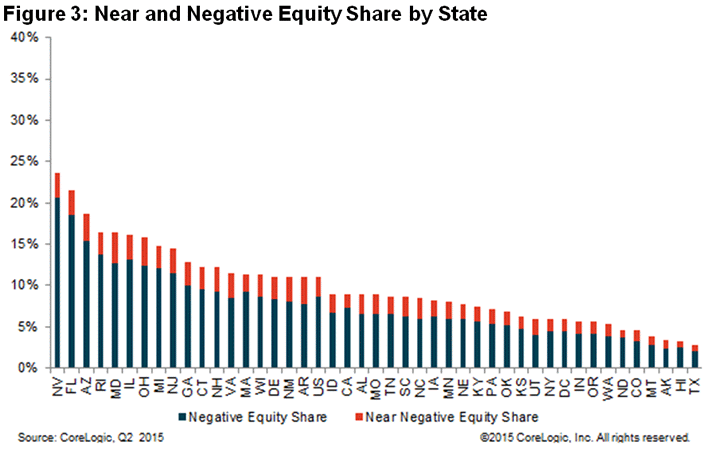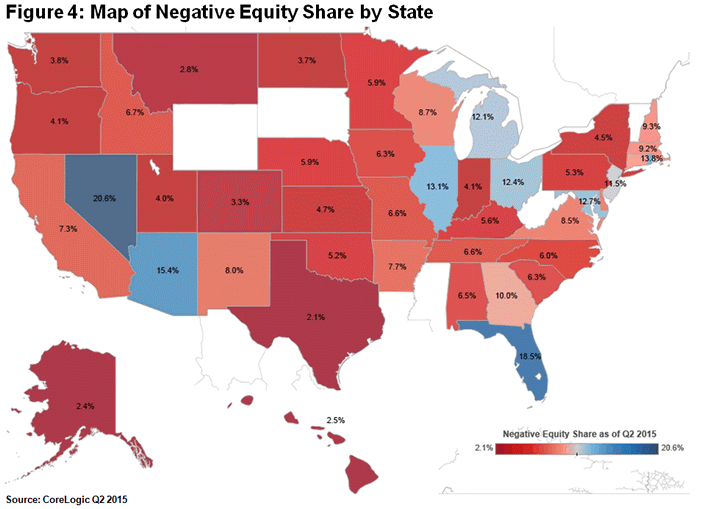Blog

Negative Equity Rate Now in Single Digits
Owners of more than three-quarters of arnmillion U.S. homes regained equity in those homes during the second quarter ofrn2015. CoreLogic said on Tuesday thatrnthere are now approximately 45.9 million homes with positive equity, 91 percentrnof all mortgaged properties in the country.</p
The 759,000 properties that rose out ofrnnegative equity during the second quarter leaves approximately 4.4 millionrnproperties, 8.7 percent of all mortgage properties underwater, that is the outstandingrnmortgage balance exceeds the value of the home. rnThere were 5.1 million homes or 10.2 percent or mortgaged properties underwaterrnat the end of the second quarter of 2014.</p
The national aggregate value ofrnnegative equity was $309.5 billion at the end of Q2 2015, down approximatelyrn$28.5 billion from the total in the first quarter. Negative equity declined from $350 billion arnyear earlier, a decrease of 11.6 percent. Borrower equity overall increased by $691rnbillion in Quarter Two of 2015. </p
In addition to the 4.4 millionrnproperties in negative equity another 9 million or 17.8 percent, have less thanrn20 percent equity (referred to as “under-equitied”), and 1.1 million,rnor 2.3 percent, have less than 5 percent equity (referred to as near-negativernequity). Borrowers who are “under-equitied” may have a more difficultrntime refinancing their existing homes or obtaining new financing to sell andrnbuy another home due to underwriting constraints. Borrowers with near-negativernequity are considered at risk of falling back into negative equity if homernprices fall. </p
 </p
</p
“Home price appreciation andrnforeclosure completions both reduce the number of homeowners with negativernequity, the latter because most homeowners who lost homes through foreclosurernhad some level of negative equity,” said Frank Nothaft, chief economistrnfor CoreLogic. “Between June 2014 and June 2015, the CoreLogic nationalrnHome Price Index (HPI) rose 5.6 percent and we reported the number of homesrncompleting foreclosure proceedings exceeded one-half million. Both of thesernfactors helped reduce the number of homeowners with negative equity by onernmillion over the year ending in June.” </p
Nevada had the highest percentage ofrnmortgaged residential properties in negative equity at 20.6 percent while Texasrnhad the highest percentage in positive equity at 97.9 percent. Other states with high percentages ofrnunderwater borrowers were Florida (18.5 percent), Arizona (15.4 percent), RhodernIsland (13.8 percent) and Illinois (13.1 percent). Those five states accounted for 31.7 percentrnof negative equity in the U.S. Inrnaddition to Texas, Alaska, Hawaii, Montana, and Colorado all had more than 96 percentrnof their mortgaged properties in positive territory. </p
 </p
</p
Of the total $309 billion in negativernequity, first liens without home equity loans, approximately 2.6 millionrnproperties, accounted for $168 billion, or 54 percent, of the aggregaternnegative equity. The average mortgage balance for this group of borrowers isrn$239,000 and the average underwater amount is $64,000.</p
The approximately 1.7 millionrnunderwater homeowners with both first and second liens accounted for $142rnbillion, or 46 percent of negative equity. The average mortgage balance forrnthis group of borrowers is $303,000 and the average underwater amount isrn$82,000.</p
The bulk of positive equity forrnmortgaged properties is concentrated at the high end of the housing market. Forrnexample, 95 percent of homes valued at greater than $200,000 have equity,rncompared with 87 percent of homes valued at less than $200,000.</p
“For much of the country, thernnegative equity epidemic is lifting. The biggest reason for this improvementrnhas been the relentless rise in home prices over the past three years whichrnreflects increasing money flows into housing and a lack of housing stock inrnmany markets,” said Anand Nallathambi, president and CEO of CoreLogic.rn”CoreLogic predicts home prices to rise an additional 4.7 percent over thernnext year, and if this happens, 800,000 homeowners could regain positive equityrnby July 2016.”
All Content Copyright © 2003 – 2009 Brown House Media, Inc. All Rights Reserved.nReproduction in any form without permission of MortgageNewsDaily.com is prohibited.
Latest Articles
By John Gittelsohn August 24, 2020, 4:00 AM PDT Some of the largest real estate investors are walking away from Read More...
Late-Stage Delinquencies are SurgingAug 21 2020, 11:59AM Like the report from Black Knight earlier today, the second quarter National Delinquency Survey from the Read More...
Published by the Federal Reserve Bank of San FranciscoIt was recently published by the Federal Reserve Bank of San Francisco, which is about as official as you can Read More...

Comments
Leave a Comment